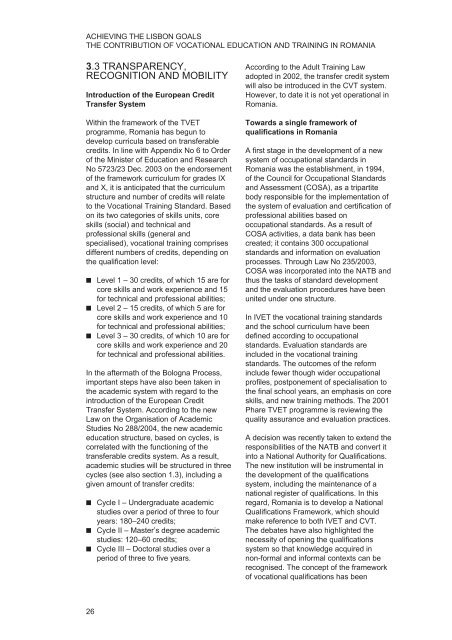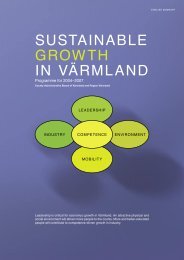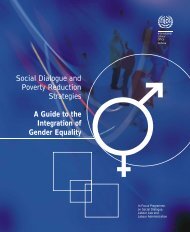PDF (222 KB) - Document Database website
PDF (222 KB) - Document Database website
PDF (222 KB) - Document Database website
You also want an ePaper? Increase the reach of your titles
YUMPU automatically turns print PDFs into web optimized ePapers that Google loves.
ACHIEVING THE LISBON GOALS<br />
THE CONTRIBUTION OF VOCATIONAL EDUCATION AND TRAINING IN ROMANIA<br />
3.3 TRANSPARENCY,<br />
RECOGNITION AND MOBILITY<br />
Introduction of the European Credit<br />
Transfer System<br />
Within the framework of the TVET<br />
programme, Romania has begun to<br />
develop curricula based on transferable<br />
credits. In line with Appendix No 6 to Order<br />
of the Minister of Education and Research<br />
No 5723/23 Dec. 2003 on the endorsement<br />
of the framework curriculum for grades IX<br />
and X, it is anticipated that the curriculum<br />
structure and number of credits will relate<br />
to the Vocational Training Standard. Based<br />
on its two categories of skills units, core<br />
skills (social) and technical and<br />
professional skills (general and<br />
specialised), vocational training comprises<br />
different numbers of credits, depending on<br />
the qualification level:<br />
<br />
<br />
<br />
Level 1 – 30 credits, of which 15 are for<br />
core skills and work experience and 15<br />
for technical and professional abilities;<br />
Level 2 – 15 credits, of which 5 are for<br />
core skills and work experience and 10<br />
for technical and professional abilities;<br />
Level 3 – 30 credits, of which 10 are for<br />
core skills and work experience and 20<br />
for technical and professional abilities.<br />
In the aftermath of the Bologna Process,<br />
important steps have also been taken in<br />
the academic system with regard to the<br />
introduction of the European Credit<br />
Transfer System. According to the new<br />
Law on the Organisation of Academic<br />
Studies No 288/2004, the new academic<br />
education structure, based on cycles, is<br />
correlated with the functioning of the<br />
transferable credits system. As a result,<br />
academic studies will be structured in three<br />
cycles (see also section 1.3), including a<br />
given amount of transfer credits:<br />
<br />
<br />
<br />
Cycle I – Undergraduate academic<br />
studies over a period of three to four<br />
years: 180–240 credits;<br />
Cycle II – Master’s degree academic<br />
studies: 120–60 credits;<br />
Cycle III – Doctoral studies over a<br />
period of three to five years.<br />
According to the Adult Training Law<br />
adopted in 2002, the transfer credit system<br />
will also be introduced in the CVT system.<br />
However, to date it is not yet operational in<br />
Romania.<br />
Towards a single framework of<br />
qualifications in Romania<br />
A first stage in the development of a new<br />
system of occupational standards in<br />
Romania was the establishment, in 1994,<br />
of the Council for Occupational Standards<br />
and Assessment (COSA), as a tripartite<br />
body responsible for the implementation of<br />
the system of evaluation and certification of<br />
professional abilities based on<br />
occupational standards. As a result of<br />
COSA activities, a data bank has been<br />
created; it contains 300 occupational<br />
standards and information on evaluation<br />
processes. Through Law No 235/2003,<br />
COSA was incorporated into the NATB and<br />
thus the tasks of standard development<br />
and the evaluation procedures have been<br />
united under one structure.<br />
In IVET the vocational training standards<br />
and the school curriculum have been<br />
defined according to occupational<br />
standards. Evaluation standards are<br />
included in the vocational training<br />
standards. The outcomes of the reform<br />
include fewer though wider occupational<br />
profiles, postponement of specialisation to<br />
the final school years, an emphasis on core<br />
skills, and new training methods. The 2001<br />
Phare TVET programme is reviewing the<br />
quality assurance and evaluation practices.<br />
A decision was recently taken to extend the<br />
responsibilities of the NATB and convert it<br />
into a National Authority for Qualifications.<br />
The new institution will be instrumental in<br />
the development of the qualifications<br />
system, including the maintenance of a<br />
national register of qualifications. In this<br />
regard, Romania is to develop a National<br />
Qualifications Framework, which should<br />
make reference to both IVET and CVT.<br />
The debates have also highlighted the<br />
necessity of opening the qualifications<br />
system so that knowledge acquired in<br />
non-formal and informal contexts can be<br />
recognised. The concept of the framework<br />
of vocational qualifications has been<br />
26








